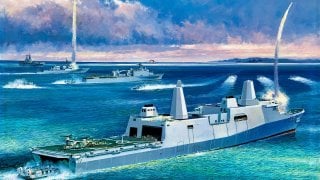Forget Aircraft Carriers: This Might Be the Most Important Navy Warship Today
The U.S. Navy's San Antonio-class amphibious transport docks (LPDs) project power globally by transporting and landing Marines, their equipment, and supplies for various expeditionary warfare missions.
Summary and Key Points: The U.S. Navy's San Antonio-class amphibious transport docks (LPDs) project power globally by transporting and landing Marines, their equipment, and supplies for various expeditionary warfare missions.
-The recently commissioned USS Richard M. McCool Jr. is the 13th LPD and the last of the Flight I series.
-The Navy plans to build 13 Flight II variants, incorporating over 200 changes to enhance their capabilities.
-Measuring 684 feet and displacing 25,300 tons, LPDs can carry four MV-22 Ospreys and are equipped with advanced radar systems for air and missile defense.
-The LPDs are expected to play a crucial role in deterring and countering threats, particularly from China.
San Antonio-Class LPDs: The Navy's Power Projectors Beyond Aircraft Carriers
The mighty aircraft carrier is not the only U.S. Navy vessel used to project power around the globe. The San Antonio-class amphibious transport dock, or landing platform dock (LPD), also carries American power to faraway places.
The LPD can “embark, transport, and land elements of a landing force for a variety of expeditionary warfare missions,” the Navy explains. Specifically, the LPD is used “to transport and land Marines, their equipment and supplies by embarked landing craft, air cushion (LCAC) or conventional landing craft and amphibious assault vehicles (AAV).” The LPD is especially handy supporting “amphibious assault, special operations or expeditionary warfare missions” and can even “serve as a secondary aviation platform for amphibious ready groups.”
The LPD mission
Recently, the Navy commissioned the 13th San Antonio-class LPD, USS Richard M. McCool Jr. The newest LPD was named for a Medal of Honor recipient who earned distinction for his actions after a kamikaze attack on USS LSC 122 during the Battle of Okinawa.
The McCool will be the last of the Flight I San Antonio-class ships. The Navy plans to build another 13 Flight II variants. These vessels will incorporate more than 200 changes from the Flight I ship and will include airport, seaport, and hospital operations. Two Flight II variants have already been laid down – USS Harrisburg and USS Pittsburgh. Four more are planned through FY29. The remaining seven will likely follow in the 2030s.
The LPD measures 684 feet long and can displace 25,300 tons when fully loaded. For propulsion, it relies on four sequentially turbocharged marine Colt-Pielstick diesel engines capable of generating 41,600 horsepower for a top speed over 22 knots. The vessel can accommodate four MV-22 Ospreys on the deck, with one in the hangar. Two Ospreys can land and take off simultaneously.

While commissioning McCool, the Navy described the LPD as “sovereign sea bases from which Marines can carry out a wide variety of missions.” Gen. C.J. Mahoney commended the LPD’s integrated SPY-6 air and missile defense radar system and its Next Generation Surface Search Technology, a software-defined radar system the Navy is developing to replace the AN/SPS-67 and AN/SPS-73 radars. This upgrade should help improve the Navy and Marine Corps’s situational awareness, with a flexible and adaptable radar system that can perform surface search and periscope search.
Adm. Lisa Franchetti, chief of naval operations, complimented the LPD as “the workhorse of our Amphibious Fleet,” adding that the McCool commissioning “puts another player with more capability on the field in America’s warfighting Navy, providing more options to our Nation’s leaders to deter and if necessary, fight and win our Nation’s wars in this decade and beyond.”
Presumably Franchetti is referring to a prospective conflict with China, which is engaged in an aggressive shipbuilding spree while simultaneously making more assertive claims throughout the Indo-Pacific region. Franchetti’s LPD remarks imply heavily that the LPD will be used to deter and counter China.
About the Author: Harrison Kass
Harrison Kass is a defense and national security writer with over 1,000 total pieces on issues involving global affairs. An attorney, pilot, guitarist, and minor pro hockey player, Harrison joined the US Air Force as a Pilot Trainee but was medically discharged. Harrison holds a BA from Lake Forest College, a JD from the University of Oregon, and an MA from New York University. Harrison listens to Dokken.
Image Credit: Creative Commons.


